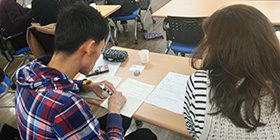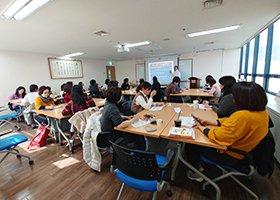Even Among the Same Japanese-Language Teachers, When the Location Changes the Needs are Varied also
The Japan Foundation, Seoul
FUJITA Tomohiko
1. Producing More Confident Japanese-Language Teachers through Conversations between Japanese-Language Teachers
According to the Survey on Japanese-Language Education Abroad 2018 by The Japan Foundation (hereinafter “JF”), learners studying Japanese at secondary educational school account for more than 70% of Japanese-language learners in Korea. Supporting teachers and learners at secondary educational schools is an important duty of the JF, Seoul. That being the case, I make regular school visits to the middle schools and high schools in the Busan/Gyeongsang region that I oversee, but shortly after I was dispatched here a certain teacher informed me of a problem. At the time we were preparing for a class and I was speaking in Korean, but the teacher said: “Would you please speak to me in Japanese? Because ordinarily I have no opportunities to speak Japanese directly to Japanese people, or to hear it, and would like to get some listening practice as well. Year after year, I only teach beginners class, so I speak 90% Korean during the class.” With the limited number of hours, the teachers do indeed begin teaching each spring with hiragana as the starting point, and they end up only teaching some of conjugations of general verbs, even though they teach over the course of the year. Furthermore, one comment I heard at another school was that “I think my level of Japanese was highest when I graduated university and became a Japanese-language teacher.” It made me aware there are teachers who are teaching the Japanese language even though they do not have confidence in their own speaking or listening ability.
In retrospect, even in Japanese-language training, I had been getting the feeling that the teachers similarly harbored some awareness that they may not be up to speaking and listening to Japanese. Even though they are happy to listen when a native Japanese-language speaker talks in a lecture-type format, participation declines when it comes time for the teachers to give presentations in Japanese or take part in group activities using Japanese, and in the case of online training, when the lecture ends and group activities are held following a short break, some teachers exit the training at that point.
In light of that, I concluded that to begin with the chief priority was to create opportunities for teachers to talk with native Japanese speakers, and from November 2019, I began a study group known as the “Japan-Korea Exchange Study” (hereinafter the “Study”). In relation to this, I referred to a classroom method known as “Tandem,” and decided to basically hold the Study in a one-on-one format to increase the amount of speaking. When recruiting participants, I limited the Study to teachers only, and there were two reasons for that. The first is that I believed if the participants are all teachers, they will also have a lot of points in common, and will likely be able to discuss work-related concerns. Another reason was out of consideration for Korean Japanese-language teachers, many of whom are highly experienced. Due to the influence of Confucianism in Korea, there is a deeply-rooted culture of respecting your elders, and there is a culture of absolute honorifics, with respectful language used even within families. In more than a few cases, a polite way of speaking is maintained even in close relationships. As a result, young people display a tendency to refrain from directly pointing out and try to correct mistakes made by people who are quite a bit older than them. In light of that, I had concerns that participants could feel offended by having various things pointed out to them when meeting for the first time, and furthermore, having them pointed out by ordinary young people who are not teachers. In that regard, I thought that even if participants had various things pointed out to them by individuals quite a bit younger than them, they would likely accept the points made without resistance if those individuals were also teachers. I believe I was probably overthinking it, but fortunately there have been no problems thus far and the number of repeat participants is gradually increasing as well.
I take a survey after every Study session, and have noted a tendency for participants’ confidence about speaking to improve even after taking part in one session. I believe the Study probably allows them to accumulate positive experiences – namely, they find they are able to have a natural conversation with the native speaker using their own Japanese, and are able to listen and respond properly as a result of talking for a reasonable length of time with a native speaker. Additionally, I expect they will probably put this confidence to work in the school classrooms where they teach Japanese. So, I believe that going forward, the Study will contribute to further increasing the number of teachers who are able to teach the Japanese language with confidence.

Japan-Korea Exchange Study
2. What Novice Native Japanese-Language Teachers Acquire in Training is the Confidence to Teach
There is a large number of Japanese nationals in Korea who have married Koreans and are living in Korea, having shifted their lifestyle base to Korea from Japan. In Busan, there is a reciprocal assistance group called “Sakura no kai,” which is made up of Japanese women who have married Koreans, and at one point the group’s representative sought my advice. In many cases, these Japanese women get asked by acquaintances to teach them Japanese, simply because the women are native Japanese speakers. Over time, a large number become teachers of Japanese without having studied how to teach it. It appears that in many cases the learners are happy simply to be able to speak Japanese to a native speaker, so the classes involve free talking. Nevertheless, in cases where there is something the learner is curious about or when their mistakes are pointed out, the learners will ask why in minute detail. Often the Japanese women are unable to explain the reason skillfully, however. The Sakura no kai representative asked me if I could come up with a venue where these inexperienced teachers could study how to teach Japanese. At first, she said she wanted me to do a one-off lecture, so I held a “Training Session for Freelance Teachers” as a trial, but it attracted more participants than I had anticipated, and gave me an insight into the number of Japanese-language teachers teaching Japanese privately, and the latent demand for Japanese-language teaching methods, so I decided to provide teachers who are giving classes with a regular opportunity to learn even while feeling uneasy doing so.
I began the training from February 2020 and since many inexperienced teachers would be participating, I named it the “Japanese-Language Teachers’ Tamago Club.” To make it easy for them to attend, I decided to hold it twice a month on a weekday evening and a weekend afternoon, and cover the same topic. In months where the topics are grammar or conversation, actively working experienced teachers who are Korean also participate. When I switched to holding the training online due to the impact of the COVID-19 pandemic, teachers from outside Busan and Gyeongsang began taking part as well, and it has grown into a popular training session that attracts from 30 to around 40 people each month. In particular, holding it online has also made it possible for housewives who are raising children and are unable to go out to participate, and they are extremely grateful. Sometimes we catch a glimpse of their children appear on their screens and it is a heartwarming feeling. I believe that providing training that is accessible to people like this, who feel they would like to learn but face environmental difficulties doing so, is one way of reaching out to freelance Japanese-language teachers. There are also some participants who want to teach Japanese in the future as part of their preparation for teaching the Japanese language. Striving to raise the standard among Japanese teachers who are inexperienced and whose teaching methods are still not proficient will undoubtedly serve to increase learners’ satisfaction and encourage them to continue learning. There may even be learners who decide they want to learn the language seriously and begin studying at a Japanese-language educational institution. In that sense, I think this training will play an important part in increasing Korea’s population of Japanese-language learners, if even by a small amount.

The Japanese-Language Teachers’ Tamago Club
- What We Do Top
- Arts and Cultural Exchange [Culture]
- Japanese-Language Education Overseas [Language]
- Japanese-Language Education Overseas [Language] Top
- Learn Japanese-language
- Teach Japanese-language
- Take Japanese-Language Test
- Know about Japanese-language education abroad
- The Japanese-Language Institute, Urawa
- The Japanese-Language Institute, Kansai
- Japanese-Language Programs for Foreign Specified Skilled Worker Candidates
- Japanese Language Education for Japanese Children Resident Overseas and for the Descendants of Migrants
- Archives
- Japanese Studies and Global Partnerships [Dialogue]
- JF digital collection
- Other Programs / Programs to Commemorate Exchange Year
- Awards and Prizes
- Publications
